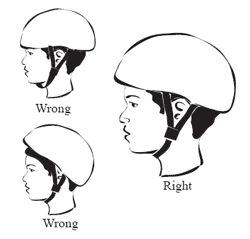Bicycle Safety
Thank you for visiting our bicycle safety page. Bike riding is fun, good exercise, and it can give your child a sense of independence. Learning safety early can help ensure a lifetime of safe bike riding. Before a child starts riding, be sure to teach them the rules of riding and always model good behavior.Helmets appropriate for bicycling should be worn by everyone – adults and children – on every bike ride. Bike helmets are not optional equipment. A helmet is your last line of defense in an accident - never ride without one! Helmets have been shown in studies to reduce the risk of head injury by 85 percent and the risk of brain injury by 90 percent.
- Step 1: Make sure the helmet fits firmly.
- Helmets are sold with foam pads that differ in thickness to make the helmet fit firmly. Use the foam pads by attaching them to the inside of the helmet until the helmet
 fits firmly on your child's head. The helmet should not move around when shaken.
fits firmly on your child's head. The helmet should not move around when shaken. - Step 2: Make sure the helmet sits level on the child's head.
- This means the helmet should cover the top of the forehead, just above the eyebrows. Wearing the helmet too far back is a common mistake. You should be able to place just two fingers between the eyebrows and the front of the helmet. Take off anything that could change the way a helmet fits (baseball caps, big hair clips, headphones, etc.)
Step 3: Position the straps correctly.- All straps should be snug but still comfortable. Fix the side straps so that they fit around your child's ear in a V-shape. Adjust the buckles or slides on the side strap so that they are right under theear. Tighten the chin strap until you can fit just one finger between the strap and your child's chin.
- Check the fit of the helmet every time. Use the 2-V-1 finger test. Teach your child to do this test each time he gets ready to ride:
- Two fingers above the eyebrows
- V-Shape under each ear
- One finger under the chin strap
- Make sure that the helmet has a label to say that it meets safety standards, such as CSA, CPSC, ASTM, or Snell
After taking a serious hit, helmets lose their capacity to absorb shock. They're designed that way so that the inner foam structure is altered by a very hard blow. If your child ever has a significant fall or hits any surface hard with the helmet, immediately replace the helmet. Don't Negotiate. It is estimated that 75% of bicycle-related deaths among children could be prevented with a bicycle helmet. Wearing one should never be optional for your child.
Maryland: State law requires all riders under 16 years of age to wear a helmet when on a bicycle. In addition to bicycles, all youth under 16 are also required to wear a helmet when on scooters, skateboards, and inline skates. Montgomery County requires all riders under 18 years of age to wear a helmet when on a bicycle. Sykesville requires a helmet for riders of all ages. (More information on the law click here )

